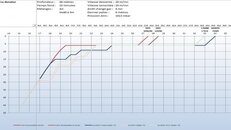I've pondered this question before (dealing with computer failure, etc.), as even as a new diver, I've already had my computer crap out on me once (low battery, wouldn't go into dive mode). I realized that it takes me about 1:30 to sing the Star Spangled Banner, or O Canada, so if I sing both, that's an easy way to time a safety stop. Maybe adding on La Marseillaise or God Save the Queen would give some extra safety margin. More fun than counting to slowly to 200.

(Aside: I'm pretty good with mental arithmetic, so I've been curious to collect various mental rules-of-thumb and tricks for diving safely with equipment failure. E.g., someone recently mentioned that it was easy to memorize the NOAA O2 CNS exposure table, and indeed from a PO2 of 1.20 to 1.50, everything is nicely linear and easy to remember. Or, I've heard of an old rule of thumb that dive time in minutes plus max depth in feet should not exceed 120 -- which is pretty close to what PADI's RDP shows for typical recreational depthsi; I think 110 would make it strictly more conservative than the RDP. But this is a topic for a different thread, and probably not in the Basic forum, where the message is unequivocally:
get a computer, or at least a watch, and know how to plan your dives with it.)






